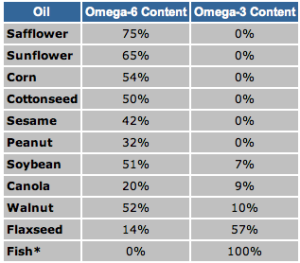
Modern diets are delicious, but they are ridiculous.
Our mindless eating over the last 50 years have skyrocketed numbers of diseases including asthma, eczema, psoriasis, cancer, heart disease, diabetes…
What we put into our body is equivalent to how our body will function; our overall health is determined by what we eat.
When our body is fed up with toxic wastes, it responds by hinting us with diseases.
Due to the rapid transformations of the way we process food, the Western diets have immensely went off-scale.
Here are the major problems:
1. The EFAs Ratio
EFA, Essential Fatty Acids, are critical fats that our body needs for good health. Only two types are essential for humans: omega-3 and omega-6.
Omega-6 fatty acids are found in most vegetables oils, and omega-3 fatty acids are found in most fish.
The problem is, omega-6 consumption today is off-scale by 10:1 to 20:1, and 25:1 in some cases.

The proper ratio of both fatty acids is 1:1, an unbalanced ratio will directly affect a person’s mood, behaviour and inflammatory responses.
Excessive consumption of omega-6 fatty acids are linked to an increase in all inflammatory diseases, and that is not to exclude, eczema.
So, eat less vegetable oil (use more omega-3 oils like olive oil) and eat more fish, about 2-3 servings per week.
2. Sodium-Potassium Ratio
Just like omega-3 and omega-6, our sodium levels are off-balance with potassium levels. Our sodium levels are higher by 12.5-37.5:1 and our potassium levels are deficient by 0.53:1.
By rebalancing our ratio – reducing sodium(salt) intake and increasing potassium intake, it will calm down our blood vessel walls and lower blood pressure.
There is a direct correlation between high blood pressure and sodium consumption, if you have loved ones with blood pressure problems, let them know salt is their worst enemy and potassium is their best friend.
Here are ten foods extremely rich in potassium:
- Swiss chard
- Spinach
- Beets
- Brussels sprouts
- Broccoli
- Cantaloupe
- Tomatoes
- Asparagus
- Cabbage
- Carrots
Proper sodium-potassium ratios should be 1:1.5.
Stop bombing yourself with salt and start eating more vegetables, in the first few days your crave for the salty taste may be crazy, but after this transformation period, you’ll begin to enjoy the real taste of natural foods.
It is understandable that the craving for saltiness can get very strong, if for any meal you eat a lot of sodium, and trust me it happens, I recommend you to eat a pure alkalizing dish of potassium-rich veggies to balance it out. But remember, the balance only gets back to optimum if you do both: reducing sodium intake and raising potassium intake, not just either one step.
3. Acid-Alkaline Ratios
Like the two ratios above, the acid-alkaline ratio is another balance that has prevalently gone off scale.
Most alkaline foods are vegetables plus some fruits and the rest are basically acidic, but there isn’t really any general rule of thumb, the pH effect of foods is sometimes quite unpredictable.
For complete charts please go to Acid-Alkaline Food Charts. (first part made for eczema sufferers)
The proper ratio of acid and alkaline foods should be 1:4.
Here’s a note: the pH of foods does not equal to the pH effect of foods. The common example is that a lemon is acidic outside but it has an alkalizing effect inside the body.
I suggest you learn to read nutrition labels on everything you eat, it’s a great habit to have, you never know the reason behind the tastiness of something until you see the horrible food colourings, addictives and preservatives.
4. Fibre Content & GI
The fibre content of foods have decreased due to refinement and processing.
When the fibre content of a food decreases, it becomes denser in terms of carbohydrates, increasing its glycemic index (GI) and produces a spike in blood sugars, causing insulin levels to rise, leading to a sudden rise in blood pressure followed by a sudden drop in blood pressure after.
Fibre is a good substance because it is indigestible by the human gut, so that it helps food release sugar at a slower rate, helping the blood levels maintain steady pressure without big fluctuations.
Many people today are consuming high-calories low-fibre foods which are promoting unhealthy eating habits (because low-fibre foods are less filling so we eat more to compensate), increasing unnecessary body weight and spiking up blood sugar levels.
Carbohydrates have two types: simple and complex.
The glycemic index (GI) measures how fast and how much a food can cause a rise in blood glucose levels. The lower GI, the slower it releases energy, the better for health.
Simple carbohydrates include: soft drinks, syrups, white flour products, sweets and even fruits and vegetables (they exist in nature but that doesn’t mean you shouldn’t eat any).
Complex carbohydrates include: whole grains, fruits, vegetables, legumes and dairy products (recommended avoiding these if you have eczema).
The best foods are high in fibre and low in carbohydrates, favour them instead of those sugary and artificial snack bars packed in a tiny package with high GI.
Here are twelve great high-fibre low-carbohydrates foods:
| Food | Serving | Fiber | Carbohydrates |
| Avocado | 1 medium-sized | 11g | 17g |
| Artichoke | 1 medium-sized | 10g | 14g |
| Raspberries | 1 cup | 8g | 15g |
| Blackberries | 1 cup | 8g | 15g |
| Lentils | ½ cup | 8g | 10g |
| Black beans | ½ cup | 7g | 22g |
| Broccoli | 1 cup | 6g | 9g |
| Veggie soup | 1 bowl | Varies | Varies |
| Pear | 1 medium-sized | 4.5g | 20g |
| Apple | 1 medium-sized | 4g | 23g |
| Oatmeal (cooked) | 1 cup | 4g | 27g |
| Barley | ½ cup | 3g | 22g |
Check out Harvard Medical School’s GI list of 100+ common foods.
5. Micronutrients
For the same reason as above, foods are depleted of micronutrients during processing and refinement.
But also, crops today contain less nutritional content compared to a few decades ago by as much as 50% in some cases, due to the excessive use of industrialized farming methods over the years. This means to acquire our daily dose of required nutrients, we may need to eat the same food but more of it.
The problem is:
- Not everyone knows this so they are partially deficient in certain micronutrients.
- And those who know that and are eating enough, are not exercising enough to balance the calories back down.
Micronutrients are nutrients (in smaller amounts) that are necessary for us to acquire optimal health every day including: microminerals like iron, chromium, zinc; vitamins and organic acids.
Here is a list of micronutrients, and a list of macronutrients (consumed in higher quantities).
What you can do about this modern day issue is to remember to: eat fresh, organic, not artificially processed fruits, vegetables, nuts and meats, so you may acquire the maximum nutritional content of foods without eating “extra copies”.
What You Should Do About Today’s Diets
The diets today are ridiculous, don’t be so happy eating artificial food, everything comes at a price – no sooner or later, what you are putting into your mouth will be reflected by a disease your body chooses to impose on you.
By then, it’s too late, so start making dietary changes today.
What you should do in your meals:
- Eat 50% natural and alkalizing vegetables each meal. (here’s the acid-alkaline food list)
- Eat 25% high-fibre complex carbohydrates: whole-grains.
- Eat 25% low-fat unprocessed proteins: lean meats. Don’t eat the fat.
- Cut down on salt, sugar, vegetable oils and substitute that with omega-3 oils (e.g. olive oil).
By the way, did you know that 61% of Americans are now either overweight or obese, and 310,000-580,000 deaths occur every year due to obesity and physical inactivity? (source)
Don’t risk your health for anything, it’s all we’re made of. Let’s sum up the issues with modern diets:
- We consume approximately 15 times more omega-6 fatty acids than omega-3 fatty acids. The healthy ratio is 1:1.
- We consume approximately 25 times more sodium than potassium. The healthy sodium-potassium ratio is 1:4.
- We consume approximately 35 times more (derived from two stats above) acidic foods than alkaline foods. The healthy acid-alkaline ratio is 1:4.
- We consume too much high GI, low-fibre high-carbohydrates foods; for good health, switch it around to eating more high-fibre low-carbohydrates foods.
- We consume inadequate amounts of micronutrients; for good health, eat more fresh, raw, organic foods.
Your health will always be reflected upon what you eat.
If you want good health, don’t feed yourself toxic foods. It may be difficult to do so in social conventions, you either stand up for yourself, or if you really can’t do that, make sure you boost your body detoxification process later with a highly nutritious green meal.
So what did you eat today?
Harrison,
I applaud you. I can see that I have a lot to learn from you. You have succeeded in 6 months where I have not yet overcome in 15 years. But I think you might want to rethink the area of fat in the diet. On issues such as this I look to the Weston A. Price Foundation, Mary Enig and Bruce Fife. They emphasize the benefits and the pervasive use of saturated fats in long-standing, healthy cultures. I’m looking forward to your future articles. Thanks.
Christi,
Thank you for your kind words. I will continue to study deeper via university education in nutrition! And I’m sure you can eventually overcome it. You will. You seem to know what to do too.
Regarding saturated fats, I’ve also read on Weston A. Price and various other sources, and old articles like this are much outdated. I no longer agree with the conventional “guidelines” and all, as I’m beginning to pick up the problems from my recent blast of book reading. Thanks for pointing it out!
Best regards,
Harrison
Not necessarily true with salt reducing in case of eczema. Based on Dr Batmanghelidj. PROPER amount of salt is vital. Too much potasium can triger asthma! Thou potasium is important. That’s true. Its all interconected and you should show that interconections , not some universal advices such doesn’t exist. We are in different points of metabolism.
You’re right. All of these listings shouldn’t be viewed stand-alone but instead be treated on a whole scale determined by the body’s overall diet, point in metabolism, physiological needs, exercise habits, etc. This then becomes complex. But if we don’t emphasize (as this article), it oversimplifies.